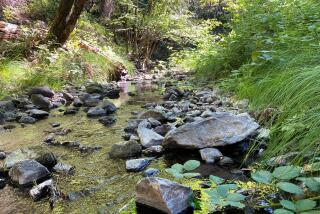Fixing a Watershed
Costly floods, chronic erosion and polluted waters are all products of the network of sloughs, washes and arroyos that snake from the rugged highlands above Somis, Moorpark, Camarillo, Simi Valley and Thousand Oaks to form the Calleguas Creek Watershed.
The low-lying Calleguas Creek, near the bottom of this natural drain, is the local waterway most likely to flood.
After 1 1/2 years of planning, about 60 different individuals, agencies and organizations have begun to meet regularly to draft a plan to collectively address the watershed’s problems.
Polluted Creeks
The creeks of the lower watershed are the county’s most polluted. Urban runoff, treated sewage water and runoff from farmland all contribute to the brew, which includes high levels of DDT, PCBs, chlordane, ammonia and nitrates.
Boundaries of watershed
Highly polluted
Medium polluted
Flood-prone areas
****
Watershed Acreage
The projected growth of the watershed’s cities over the next two decades will result in a 20% increase in urban runoff into streams. That could result in a similar increase in sediment from erosion during a typical winter storm because rainfall is funneled into drains and runs more quickly through creeks downstream.
Total watershed: 219,985 acres
1990 urban land: 46,620
Projected 2010 urban land: 83,520 acres
****
Coastal Sage Scrub: This plant community still grows on thousands of lower hillside acres in Ventura County, especially the hills north of Moorpark and Simi Valley. But sages, buckwheat and cactus are decreasing rapidly as cities grow. Two pairs of the threatened California gnatcatcher were found in 1995 in this scrub, the first since the 1920s.
Mugu Lagoon: At the mouth of the watershed lies Mugu Lagoon, one of the largest relatively undisturbed salt water marshes in Southern California, and a nursery for many fish and mammals and home of nine threatened or endangered species. But the wetland is increasingly polluted and shrinking under tons of mud and silt.
*
Brown Pelican
Habitat: Marine and estuary
Status: Endangered list, federal and state
*
California Gnatcatcher
Habitat: Coastal sage scrub
Status: On federal and state threatened lists
*
California Least Tern
Habitat: Estuary and beaches
Status: On federal and state endangered lists
*
Light-Footed Clipper Rail
Habitat: Salt- and freshwater marsh
Status: On federal and state endangered lists
Calleguas Facts
Size: 30 miles long, 14 miles wide
Drainage area: 343 square miles
Creeks: 3 dozen
Threatened and/or endangered species: 16; other candidates for listing 37
Erosion: About 1.2 million tons of soil is eroded in the watershed each year, and 412,000 tons reach Calleguas Creek, causing the creek to fill and overflow.
Population Growth: As the watershed has changed from its natural state, the erosion rate has increased 10-fold. Cities have pushed farming out of valleys and onto hillsides, increasing erosion.
City residents in watershed
1950: 12,000
1990: 282,000
Source: U.S. Department of Agriculture Natural Resources Conservation Service
More to Read
Sign up for Essential California
The most important California stories and recommendations in your inbox every morning.
You may occasionally receive promotional content from the Los Angeles Times.










